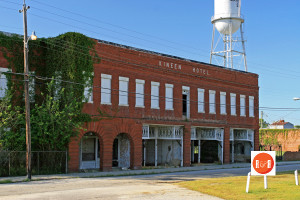“Maysville Historic District….”
City Directories and History: The Kineen Hotel dominated the landscape of Mayesville, built in ca. 1911.
The Mayesville Historic District is notable for its representation of the cultural , coiranercial, and architectural development of a small 19th century South Carolina community. The District, which encompasses the western half of the town of Mayesville, contains a concentration of structures which represent a broad range of late 19th and early 20th century vernacular architectural design, including commercial, residential and religious examples. The visual appearance of the Mayesville Historic District reflects the evolution of this small rural town which developed as the result of the changing economic forces brought about by the establishment of rail transportation and subsequent commercialization in the late ISCDs. Named for Matthew Peterson Mayes, the town of Mayesville lies in a rural section of the northeast corner of Sumter County. Matthew Mayes was a native of Virginia who moved to the Sumter District circa 1820. Mayes was a planter who built his home in the southern portion of his father-in-law’s plantation. It was around this home (no longer extant) that the Town of Mayesville developed.
During its early years, the community was little more than a scattering of homes of the Mayes family. In 1852 the Wilmington, Manchester and Columbia Railroad was extended to the Mayes’ plantation, and the “Mayes Station” Depot was established. The coming of the railroad was a major incentive to the town’s growth, and by the late 1860s, Mayesville was attracting merchants interested in building commercial enterprises. Following the Civil War, the Mayes’ plantation was subdivided as the community expanded. Mayesville was subsequently incorporated in 1874. During the late 19th century and the early years of the 20th century, Mayesville went through a period of growth and prosperity which led to the construction of the downtown commercial and residential structures.
At present, Mayesville’s physical appearance continues to be primarily that of a turn-of-the-century town. Although there are several structures from the early settlement of the town, the majority of the residential and commercial structures date from the late 19th and early 20th centuries. (SC Dept. of Archives and History)

Kineen Hotel – Photographed by Bill Segars, 2010

Kineen Hotel
Stay Connected
Explore history, houses, and stories across S.C. Your membership provides you with updates on regional topics, information on historic research, preservation, and monthly feature articles. But remember R&R wants to hear from you and assist in preserving your own family genealogy and memorabilia.
Visit the Southern Queries – Forum to receive assistance in answering questions, discuss genealogy, and enjoy exploring preservation topics with other members. Also listed are several history and genealogical researchers for hire.
User comments welcome — post at the bottom of this page.
Please enjoy this structure and all those listed in Roots and Recall. But remember each is private property. So view them from a distance or from a public area such as the sidewalk or public road.
Do you have information to share and preserve? Family, school, church, or other older photos and stories are welcome. Send them digitally through the “Share Your Story” link, so they too might be posted on Roots and Recall.
Thanks!



